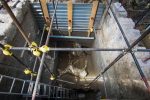 Archaeologists have made an extraordinary discovery at Pompeii: the first complete remains of a horse ever found at the ancient site. It was looters who inadvertently led them there. A joint team of archaeologists from the Archaeological Park of Pompeii and investigators from the district of Naples’ prosecutor’s office, local and cultural patrimony Carabinieri have been investigating looting activity since August, probing some tunnels recently dug by people of nefarious intent looking for artifacts to sell illegally on the black market.
Archaeologists have made an extraordinary discovery at Pompeii: the first complete remains of a horse ever found at the ancient site. It was looters who inadvertently led them there. A joint team of archaeologists from the Archaeological Park of Pompeii and investigators from the district of Naples’ prosecutor’s office, local and cultural patrimony Carabinieri have been investigating looting activity since August, probing some tunnels recently dug by people of nefarious intent looking for artifacts to sell illegally on the black market.
 The looters used the perimeter walls as guides to tunnel under, causing breaches in the walls, damaging plaster and frescoes and helping themselves to any ancient artifacts they came across. Using a laser scan mapping of 200 feet of tunnels, archaeologists excavated areas encroached upon by looters to aid in the investigation while simultaneously preserving remains harmed or endangered by the looting activity. In the service section of a grand villa less than half a mile northwest of the city walls in the suburb of Civita Giuliana, the excavation unearthed the bones of a horse killed in the 79 A.D. eruption of Vesuvius.
The looters used the perimeter walls as guides to tunnel under, causing breaches in the walls, damaging plaster and frescoes and helping themselves to any ancient artifacts they came across. Using a laser scan mapping of 200 feet of tunnels, archaeologists excavated areas encroached upon by looters to aid in the investigation while simultaneously preserving remains harmed or endangered by the looting activity. In the service section of a grand villa less than half a mile northwest of the city walls in the suburb of Civita Giuliana, the excavation unearthed the bones of a horse killed in the 79 A.D. eruption of Vesuvius.
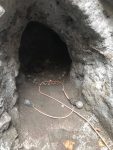 The villa had been partially excavated already in 1907-8, revealing residential rooms and some agricultural production facilities, precisely which are unclear as there is little extant documentation, but researchers believe were areas dedicated to the production or storage of wine and oil. The service area where the horse was found, a stable complete with remains of a manger, was south of the early 1900s excavation.
The villa had been partially excavated already in 1907-8, revealing residential rooms and some agricultural production facilities, precisely which are unclear as there is little extant documentation, but researchers believe were areas dedicated to the production or storage of wine and oil. The service area where the horse was found, a stable complete with remains of a manger, was south of the early 1900s excavation.
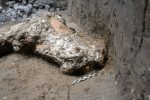 Other equines — donkeys, mules — have been found at Pompeii before, but this is the first horse. It was identified as such by its size, proportions and most specifically, by the clear imprint of its left ear made in the ground as it lay on its side. It was a large animal by the standards of the time (150 cm high, or just under 15 hands), and the remains of an iron bit and bridle and bronze fittings between its ears suggest this was a prized steed, an expensive horse owned by someone of high rank. A second, smaller equine was found in the same stall, but most of its was destroyed in a landslide. Only part of its legs remain.
Other equines — donkeys, mules — have been found at Pompeii before, but this is the first horse. It was identified as such by its size, proportions and most specifically, by the clear imprint of its left ear made in the ground as it lay on its side. It was a large animal by the standards of the time (150 cm high, or just under 15 hands), and the remains of an iron bit and bridle and bronze fittings between its ears suggest this was a prized steed, an expensive horse owned by someone of high rank. A second, smaller equine was found in the same stall, but most of its was destroyed in a landslide. Only part of its legs remain.
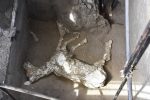 That earprint and the intact skeleton were indications that a plaster cast, the technique of preservation of Pompeiian remains pioneered in the 19th century, might be taken here. Because the horse is unique, taking a cast of it was all the more important. The cast revealed that the remains did suffer some damage in the haunches from the looters, thankfully minor.
That earprint and the intact skeleton were indications that a plaster cast, the technique of preservation of Pompeiian remains pioneered in the 19th century, might be taken here. Because the horse is unique, taking a cast of it was all the more important. The cast revealed that the remains did suffer some damage in the haunches from the looters, thankfully minor.
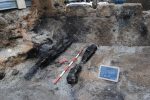 Numerous objects of daily use have been found in the villa, including amphorae, cooking utensils, and part of a carbonized wooden bed. The bed was in good enough condition that archaeologists were able to make a plaster cast of it too.
Numerous objects of daily use have been found in the villa, including amphorae, cooking utensils, and part of a carbonized wooden bed. The bed was in good enough condition that archaeologists were able to make a plaster cast of it too.